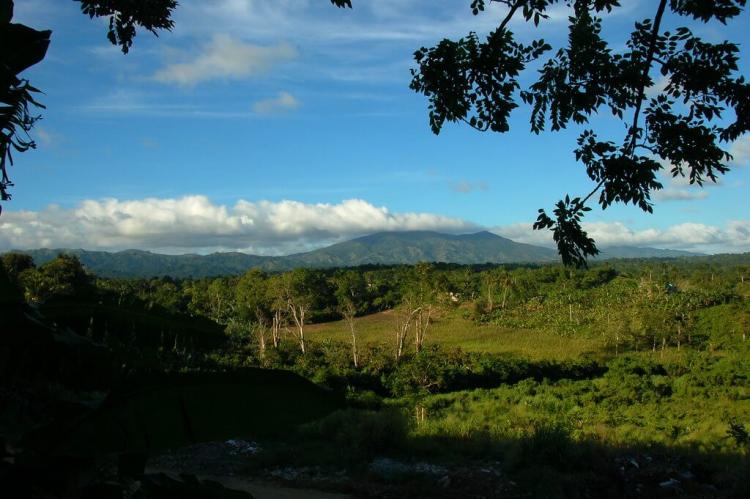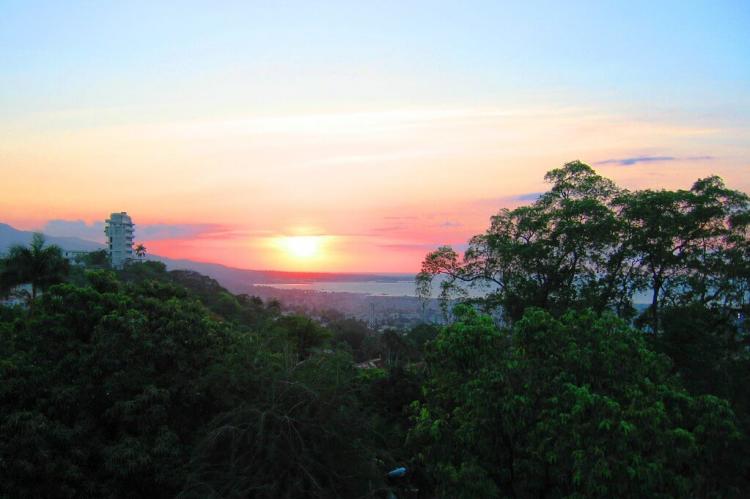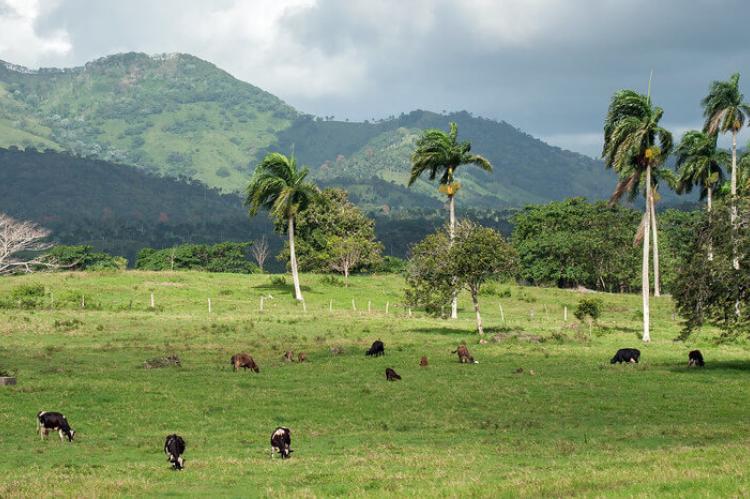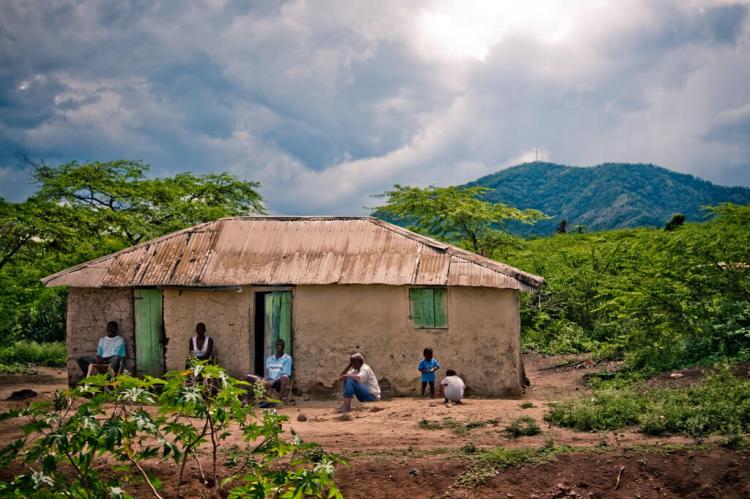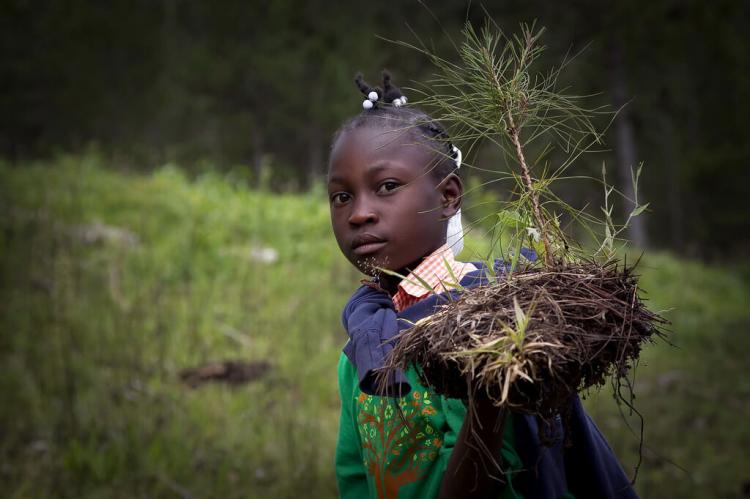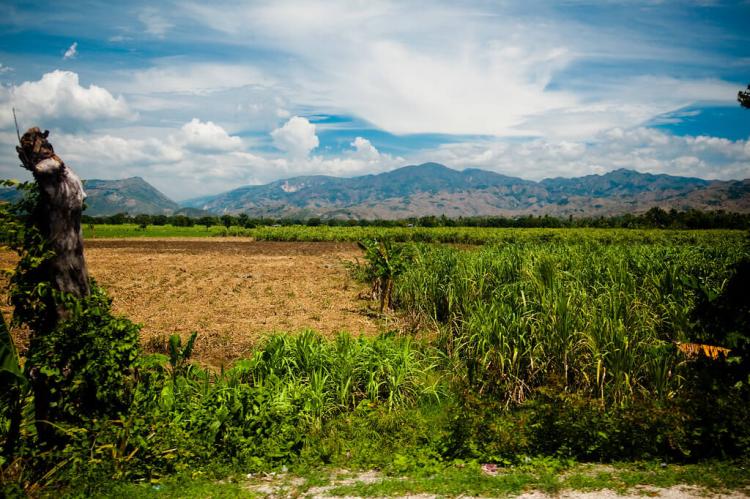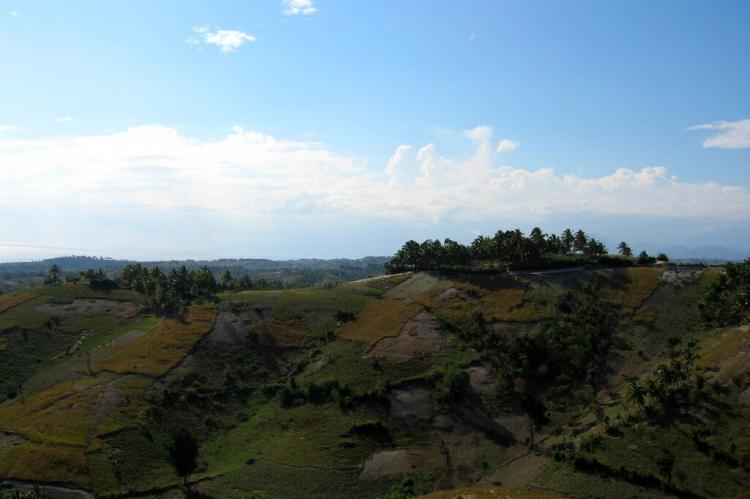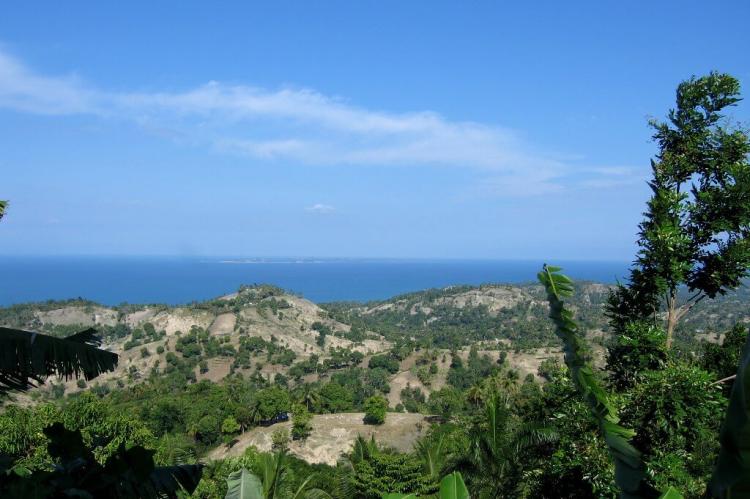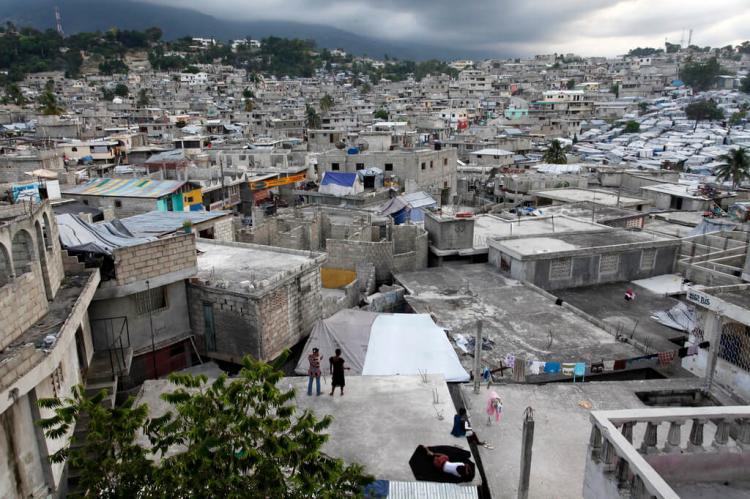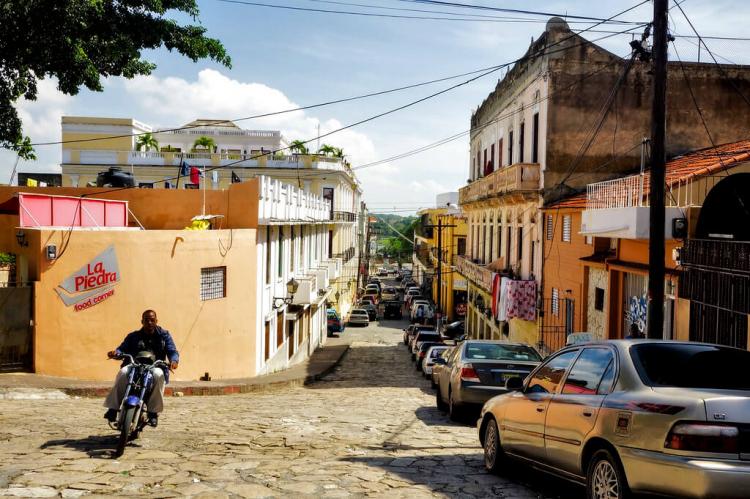Island of Hispaniola (Greater Antilles)
Hispaniola is the second largest and most populated island in the Caribbean region. It is located within the Greater Antilles and is divided politically into two sovereign nations: the Republic of Haiti and the Dominican Republic.
Island of Hispaniola
Hispaniola (La Española) is the second largest island in the West Indies, after Cuba. It is located in the Caribbean Sea, within the Greater Antilles archipelago.
The 76,192 sq km (29,418 sq mi) island is divided politically into two sovereign nations: the Republic of Haiti in the west and the Dominican Republic in the east.
The island of Cuba lies 80 km (50 mi) to the northwest, Jamaica lies 190 km (118 mi) to the southwest, and Puerto Rico lies 130 km (80 mi) to the east. Cuba, Hispaniola, Jamaica, and Puerto Rico are collectively known as the Greater Antilles.
Hispaniola is the most populous island in the Caribbean, with a combined population of almost 22 million as of April 2019.
The Dominican Republic comprises approximately 10.63 million people (2018). All Dominicans speak Spanish as the primary language. Roman Catholicism is the official and dominant religion.
Haiti is a nation of roughly 11.12 million people (2018). Although French is spoken as a primary language by the educated and wealthy minority, the entire population speaks Haitian Creole, one of several French-derived Creole languages.
In Haiti, Roman Catholicism is the dominant religion, practiced by more than one-half of the population, although in some cases, in combination with the Haitian Vodou faith. Another 25% of the populace belongs to Protestant churches. As a result, Haiti emerged as the first Black republic in the world.
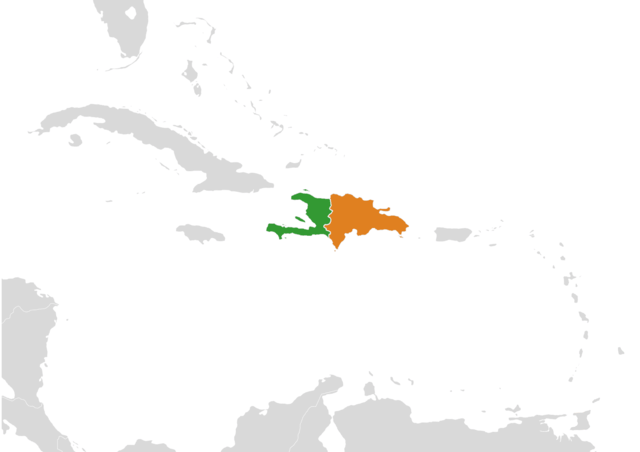
Island of Hispaniola location map
History
The primary indigenous group on the island was the Arawak/Taíno. The Arawak tribe originated in the Orinoco Delta, spreading from Venezuela. They traveled to what is now Hispaniola around 1200 CE.
The Taíno often came in contact with the Caribs, another indigenous tribe. The Caribs mainly lived in modern-day Puerto Rico and northeast Hispaniola and were known to be hostile toward other tribes.
Christopher Columbus landed on the island in 1492, named it La Isla Española (Hispaniola in its Anglicized form), and established La Navidad, the first European settlement in the Americas.
On his second voyage in 1493, Colombus established the first proper town, La Isabela, which was abandoned when the first permanent settlement and current capital of the Dominican Republic, Santo Domingo, was established in 1498.
During Spanish colonial times, the island's position on the northern flank of the Caribbean Sea provided an excellent location for control of Spanish expansion to Cuba, Mexico, Panama, and South America. During the colonial period, the island was called Santo Domingo, now the capital city's name.
The harsh enslavement practiced by Spanish colonists against the Taínos and the redirection of food supplies and labor of the indigenous for feeding Spanish settlers had a devastating impact on both the mortality and fertility of the Taíno population over the first quarter century. By 1508, the Taíno population of about 400,000 was reduced to 60,000, and by 1514 only 26,000 remained.
As Spain conquered new regions on the mainland of the Americas (Spanish Main), its interest in Hispaniola waned. However, by the early 17th century, the island and its smaller neighbors became regular stopping points for Caribbean pirates. These French, English and Dutch pirates established bases on the north and west coasts of the island.
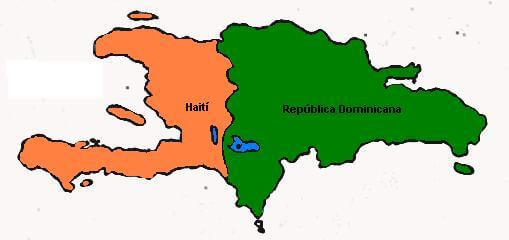
La Española
In 1665, French colonization of the island was officially recognized by King Louis XIV, and the colony was given the name "Saint-Domingue." In the 1697 Treaty of Ryswick, Spain formally ceded the western third of the island to France.
Nicknamed the "Pearl of the Antilles," Saint-Domingue became the most prosperous colony in the West Indies, with a system of human slavery used to grow and harvest sugar cane during a time when European demand for sugar was high.
In 1791, a significant slave revolt broke out in Saint-Domingue. The French Republic abolished slavery in the colonies on February 4, 1794. However, the ex-slave army joined forces with France in the war against its European neighbors. In the second 1795 Treaty of Basel (July 22), Spain ceded the eastern two-thirds of the island of Hispaniola, later to become the Dominican Republic.
Under Napoleon, France reimposed slavery in most Caribbean islands in 1802 and sent an army to bring Saint-Domingue under tighter control. However, more than half of the French army succumbed to yellow fever.
After the French removed the surviving 7,000 troops in late 1803, the revolution's leaders declared western Hispaniola the new nation of independent Haiti in early 1804. However, France continued to rule Spanish Santo Domingo.
In 1808, following Napoleon's invasion of Spain, the criollos of Santo Domingo revolted against French rule and, with the aid of the United Kingdom, returned Santo Domingo to Spanish control. The Dominican Republic's first Constitution, modeled after the U.S., was adopted on November 6, 1844.
France demanded high compensation for slaveholders who lost their property, and Haiti was saddled with unmanageable debt for decades. As a result, it became one of the poorest countries in the Americas. Yet, simultaneously, the Dominican Republic gradually developed into one of the largest economies of Central America and the Caribbean.
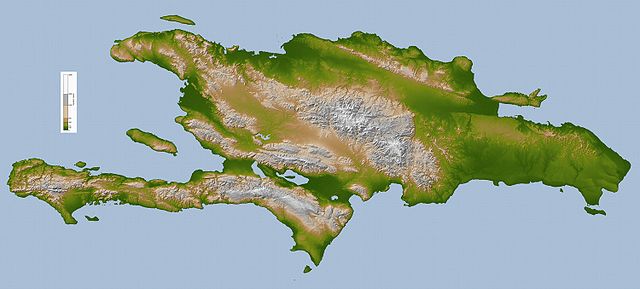
Hispaniola topographic map
Geography
The island of Hispaniola has three major mountain ranges:
-
The Cordillera Central is the highest mountain range in the Caribbean, running through the center of the island of Hispaniola. It is located in both the Dominican Republic and Haiti. The highest peak in the Cordillera Central is Pico Duarte, which reaches 3,098 m (10,164 ft).
-
The Cordillera Septentrional runs parallel to the Cordillera Central across the northern coast of the Dominican Republic, extending into the Atlantic Ocean as the Samaná Peninsula. It is the second-highest mountain range on Hispaniola, with its highest peak, Loma Alto de la Bandera, reaching an elevation of 2,277 m (7,469 ft).
-
The Sierra de Bahoruco begins in the southwestern Dominican Republic, extending west into Haiti as the Massif de la Selle and the Massif de la Hotte, which form the mountainous spine of Haiti's southern peninsula.
Climate
Owing to its mountainous topography, Hispaniola's climate shows considerable variation over short distances and is the most varied of all the Antilles.
Except in the summer season, the predominant winds over Hispaniola are the northeast trade winds, which deposit their moisture on the northern mountains and create a distinct rain shadow on the southern coast.
Temperature variations are much less marked than rainfall and depend only on altitude. However, lowland Hispaniola is generally oppressively hot and humid, with temperatures averaging 28 °C (82 °F), high humidity during the daytime, and around 20 °C (68 °F) at night.
At higher altitudes, temperatures fall steadily so that frosts occur during the dry season on the highest peaks, and maximum temperatures are no higher than 18 °C (64 °F).
Agriculture
In general, the mountains in Hispaniola are forested and sparsely populated; however, in some places in Haiti, population pressure has brought about the deforestation of land for cultivation. The main agricultural crop in the highlands is coffee.
Cacao is produced on the heavily populated northern plains. In the upper Yaque Plain, tobacco is a dominant crop. In the semi-arid lower plains, irrigated rice is the crop of choice. Along the northern coast, the Plaine du Nord, in the west of Haiti, sugarcane and sisal are the main crops.
The southern plains of the island are also very productive, boasting sugarcane, livestock pasture and cotton, although irrigation is necessary for many areas.
Fauna
Many bird species exist in Hispaniola, and the island's amphibian species are diverse. In addition, numerous land species on the island are endangered and could become extinct.
Many species are endemic to the island, including insects and other invertebrates, reptiles, and mammals. The most famous endemic mammal on the island is the Hispaniolan hutia (Plagiodontia aedium).
There are also many avian species on the island. The six endemic genera are Calyptophilus, Dulus, Nesoctites, Phaenicophilus, Xenoligea and Microligea. Unfortunately, over half of the original ecoregion has been lost to habitat destruction, impacting the local fauna.
Flora
The island of Hispaniola has four distinct ecoregions.
-
Hispaniolan moist forests: cover approximately 50% of the island, especially the northern and eastern portions, predominantly in the lowlands but extending up to 2,100 m (6,900 ft) elevation.
-
Hispaniolan dry forests: occupy approximately 20% of the island, lying in the rain shadow of the mountains in the southern and western portion of the island and the Cibao valley in the center-north of the island
-
Hispaniolan pine forests: occupies the mountainous 15% of the island, above 850 m (2,790 ft) elevation
-
Greater Antilles mangroves: surrounds a chain of lakes and lagoons in the south-central region of the island and is an element of the Flooded grasslands and savannas biome
The mountains are generally forested and sparsely populated; however, in some places, mainly in Haiti, the population pressure has brought about the deforestation of land for cultivation.
Scientists have long cited deforestation in Haiti as a source of ecological crisis; the timber industry dates back to French colonial rule. Haiti has seen a dramatic reduction of forests due to the excessive and increasing use of charcoal for cooking.
Recent in-depth studies of satellite imagery and environmental analysis regarding forest classification conclude that Haiti has approximately 30% tree cover. The country has been significantly deforested over the last 50 years, resulting in the desertification of portions of the Haitian territory.
In the Dominican Republic, the forest cover has increased. In 2003, the Dominican forest cover had been reduced to 32% of the territory, but by 2011, forest cover had grown to nearly 40%.
